Sticking with the healthier bakes again, I have opted to use Marriage's Golden Wholegrain Flour this time to see how it fared against the Allinson's Wholemeal Flour I have been experimenting with.
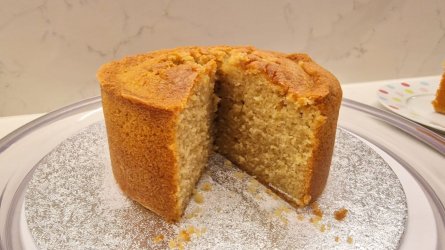
Upon opening the golden flour, I noticed it had a crumblier texture to that of the whole grain. So, with that in mind, I decided to make a Madeira cake, which is my go-to when making celebration birthday cakes. (I was hoping I could create a healthier version).
Again, using my half-and-half technique, I got to work with the recipe. However, what I didn't realise was that I substituted white self-raising flour for the plain white flour portion of the recipe.
However, even though I'd gone off script and switched out the flour, the cake turned out beautifully with warm-coloured undertones, giving the denseness of a Madeira, albeit with a slightly lighter bite.

Preheat your oven to one of the following temps:
Although the cake did turn out fine, you should opt to leave out the baking powder if you mix both self-raising and golden wholegrain plain flour together. If you use two variations of plain flour, white and golden wholegrain, then use the baking powder. I could taste the baking powder a touch in the cake, but everyone else seemed to love it.





2 Cut out the circle and measure it in the bottom of your time to ensure it fits.

3 Then cut another sheet of baking paper large enough to cover the exterior of the tin. And enough string to wrap around it. Place these to one side.

4 Weigh out the Golden Wholegrain Plain Flour.
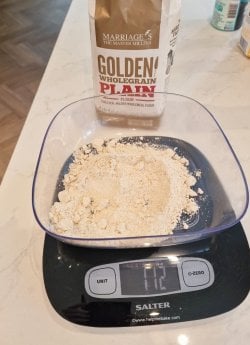
Sieve into the mixing bowl.

5 Then weigh out the white Self-Raising Flour (You could use White Plain flour here instead).

Sieve this into the mixing bowl.

6 If you have used Self-Raising Flour SKIP this step. If you have used half White and half Golden Wholegrain Plain Flour, then add the baking powder.

Sieve the baking powder into the mixing bowl.

7 Weigh out the caster sugar

I sieved this into the mixing bowl too.
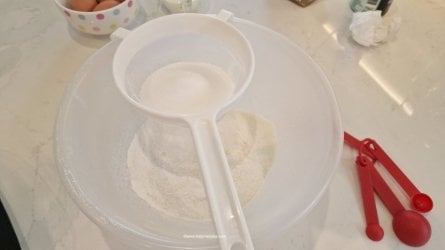
8 Weigh out the butter.
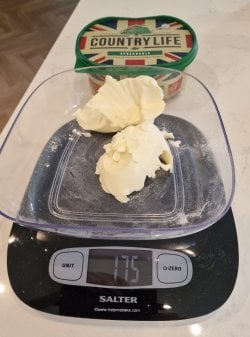
9 Add that to the mixing bowl along with the three eggs.

10 Add the milk.

11 Hand whisk all the ingredients together for about 45 seconds on high speed.

12 The ingredients should combine together.

13 I then scraped down the bowl and manually folded in the last bits of the mix until combined.

14 Once all the ingredients were mixed in, I got the cake release spray.

15 And lightly sprayed the tin.
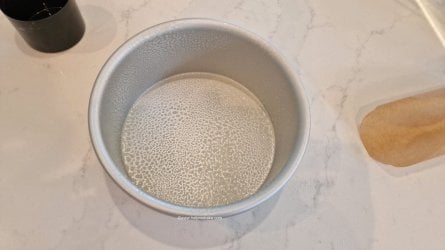
16 Then I placed the circular baking paper at the bottom of the tin.

17 You can then pour the batter into the greased lined tin.


18 Then cover the exterior of the tin with the additional baking paper and string.
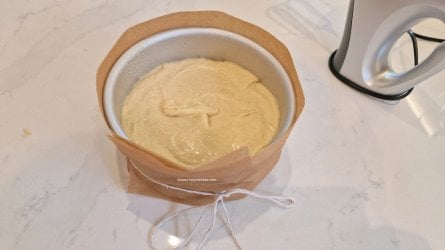
19 Place in the oven and bake in the centre or as instructed by your oven manual. I have a large-capacity oven, so I baked mine on shelf 1 as per the manual.
I baked the cake for 1 hour and 5 minutes, and even though the skewer came out clean, it was a touch underdone in the centre when we cut it. Therefore, I think 1 hour and 8 minutes would have been perfect for the cake. This is an approximation, so check yours after 1hr, and then do the skewer test until you are happy that it's done. (Every oven is different).

20 While the cake is baking, weigh out the 100 grams of sugar for the stock syrup; I use granulated sugar.
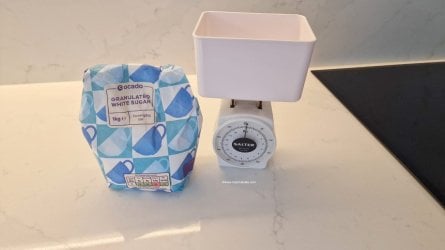
21 Then measure out 150ml of boiled water. You can use cold water if you prefer.

22 Pour both the sugar and then the water into the pan.

23 Put it on the hob on high heat, no 9. This boils the water quickly, and the sugar dissolves easily when stirred with the spatula. Once this is done take off the heat place a lid on the pan and leave to one side for later.

24 Once the cake has baked, remove it from the oven and stab it all over with a skewer.

25 Then take spoonfuls of the stock syrup and pour over the hot cake.

25 This will absorb straight in. Place the cake on a wet tea towel to help contract away from the edges of the tin.

26 Let the cake cool on a damp tea towel for 10 minutes, and cover it with a food tent.

27 Once the ten minutes is up, remove the food tent. Then take another wire rack and place it on the top of the tin/cake.

28 Squeeze the two wire racks together and flip the cake over.

29 Remove the wire rack and tea towel.
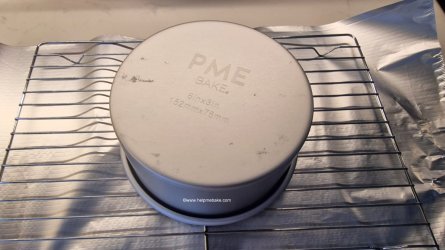
30 Very carefully slide the tin upwards off the cake. Be very careful because the tin will still be hot.

31 Then carefully peel up the baking paper, and use a palette knife to prize the paper away from the hot cake without tearing.

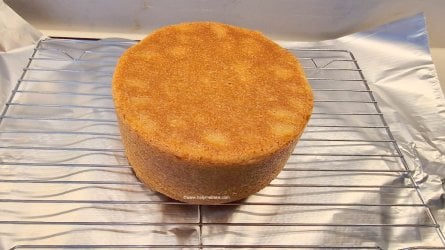
32 Cover the cake with a food tent and allow it to cool further. Then, after about ten minutes, turn the cake back over so that the wire rack doesn't stick to the top of your cake. Allow to cool fully.

33 Once fully cool, place the cake on a cleaned cake board that has been wiped down and then dusted with icing sugar. This will prevent the cake from sticking to the board. The cake was then placed on my covered cake stand.

This helps retain the moisture.

34 Slice and serve with a cup of tea.

I usually make this cake using all plain flour, which helps give the cake a dense feel. However, using both self-raising flour and golden wholegrain flour gave the cake a dense structure but a lighter bite.
I really enjoyed this cake and will be sure to make it again. It's also healthier, which is great for those birthday celebrations.
I do hope you give it a go at some point or have a go experimenting yourself and seeing what you come up with.
Enjoy and Happy Baking!

Upon opening the golden flour, I noticed it had a crumblier texture to that of the whole grain. So, with that in mind, I decided to make a Madeira cake, which is my go-to when making celebration birthday cakes. (I was hoping I could create a healthier version).
Again, using my half-and-half technique, I got to work with the recipe. However, what I didn't realise was that I substituted white self-raising flour for the plain white flour portion of the recipe.
However, even though I'd gone off script and switched out the flour, the cake turned out beautifully with warm-coloured undertones, giving the denseness of a Madeira, albeit with a slightly lighter bite.

Preheat your oven to one of the following temps:
- Fan assisted: 150°C
- Conventional Oven 160°C- 170°C
- Gas Mark 3
- Fahrenheit - 325F
Note:
When making this recipe, I actually messed up a little and used half self-raising flour instead of all half white/half golden wholegrain plain flour; I then added a teaspoon of baking powder to the mix, thinking I needed it to leaven the plain flour, which obviously I didn't because I added the self-raising flour effectively doubling up on raising agent!Although the cake did turn out fine, you should opt to leave out the baking powder if you mix both self-raising and golden wholegrain plain flour together. If you use two variations of plain flour, white and golden wholegrain, then use the baking powder. I could taste the baking powder a touch in the cake, but everyone else seemed to love it.
Ingredients:

- 112 Grams Marriage's Golden Wholegrain Plain Flour
- 112 Grams McDougall's Self-Raising McDougall's Flour
- 1Teaspoon Baking Powder - (See Note Above)
- 175 Grams Tate & Lyle Caster Sugar
- 175 Grams Countrylife Butter
- 3 Large M&S Eggs
- 2 Tablespoons Milk
Tip: Place the ingredients on the counter in the order you will use them; that way, you will remember to add everything in. Also read the label to ensure you use the correct ingredients!
Stock/Simple Syrup (Optional)

- 100 Grams Ocado Granulated Sugar
- 150 ml Water
- Spatula
- Small Pan/Hob
Equipment:

- Mixing Bowl
- 6 x 3 Inch Cake Tin
- Electric Hand Whisk
- Measuring Spoons
- Scales
- Sieve
- Spatula
- Spoon
- Wire Rack
- Baking Paper/String
- Pencil/Pen
- Tea Towel
- Greasing Agent - Bake Easy or Cake Release (Optional)
Method:
1 Place your tin on the baking paper and draw around the base with a pencil.

2 Cut out the circle and measure it in the bottom of your time to ensure it fits.

3 Then cut another sheet of baking paper large enough to cover the exterior of the tin. And enough string to wrap around it. Place these to one side.

4 Weigh out the Golden Wholegrain Plain Flour.

Sieve into the mixing bowl.

5 Then weigh out the white Self-Raising Flour (You could use White Plain flour here instead).

Sieve this into the mixing bowl.

6 If you have used Self-Raising Flour SKIP this step. If you have used half White and half Golden Wholegrain Plain Flour, then add the baking powder.

Sieve the baking powder into the mixing bowl.

7 Weigh out the caster sugar

I sieved this into the mixing bowl too.

8 Weigh out the butter.

9 Add that to the mixing bowl along with the three eggs.

10 Add the milk.

11 Hand whisk all the ingredients together for about 45 seconds on high speed.

12 The ingredients should combine together.

13 I then scraped down the bowl and manually folded in the last bits of the mix until combined.

14 Once all the ingredients were mixed in, I got the cake release spray.

15 And lightly sprayed the tin.

16 Then I placed the circular baking paper at the bottom of the tin.

17 You can then pour the batter into the greased lined tin.


18 Then cover the exterior of the tin with the additional baking paper and string.

19 Place in the oven and bake in the centre or as instructed by your oven manual. I have a large-capacity oven, so I baked mine on shelf 1 as per the manual.
I baked the cake for 1 hour and 5 minutes, and even though the skewer came out clean, it was a touch underdone in the centre when we cut it. Therefore, I think 1 hour and 8 minutes would have been perfect for the cake. This is an approximation, so check yours after 1hr, and then do the skewer test until you are happy that it's done. (Every oven is different).

20 While the cake is baking, weigh out the 100 grams of sugar for the stock syrup; I use granulated sugar.

21 Then measure out 150ml of boiled water. You can use cold water if you prefer.

22 Pour both the sugar and then the water into the pan.

23 Put it on the hob on high heat, no 9. This boils the water quickly, and the sugar dissolves easily when stirred with the spatula. Once this is done take off the heat place a lid on the pan and leave to one side for later.

24 Once the cake has baked, remove it from the oven and stab it all over with a skewer.

25 Then take spoonfuls of the stock syrup and pour over the hot cake.

25 This will absorb straight in. Place the cake on a wet tea towel to help contract away from the edges of the tin.

26 Let the cake cool on a damp tea towel for 10 minutes, and cover it with a food tent.

27 Once the ten minutes is up, remove the food tent. Then take another wire rack and place it on the top of the tin/cake.

28 Squeeze the two wire racks together and flip the cake over.

29 Remove the wire rack and tea towel.

30 Very carefully slide the tin upwards off the cake. Be very careful because the tin will still be hot.

31 Then carefully peel up the baking paper, and use a palette knife to prize the paper away from the hot cake without tearing.


32 Cover the cake with a food tent and allow it to cool further. Then, after about ten minutes, turn the cake back over so that the wire rack doesn't stick to the top of your cake. Allow to cool fully.

33 Once fully cool, place the cake on a cleaned cake board that has been wiped down and then dusted with icing sugar. This will prevent the cake from sticking to the board. The cake was then placed on my covered cake stand.

This helps retain the moisture.

34 Slice and serve with a cup of tea.

I usually make this cake using all plain flour, which helps give the cake a dense feel. However, using both self-raising flour and golden wholegrain flour gave the cake a dense structure but a lighter bite.
I really enjoyed this cake and will be sure to make it again. It's also healthier, which is great for those birthday celebrations.
I do hope you give it a go at some point or have a go experimenting yourself and seeing what you come up with.
Enjoy and Happy Baking!
